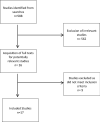A systematic review of remote otological assessment using video-otoscopy over the past 10 years: reliability and applications
- PMID: 33486567
- PMCID: PMC7828099
- DOI: 10.1007/s00405-020-06596-2
A systematic review of remote otological assessment using video-otoscopy over the past 10 years: reliability and applications
Abstract
Purpose: This systematic review describes and evaluates the current literature on remote otological assessment using video-otoscopy with regards to reliability and potential applications.
Methods: Systematic review was conducted in accordance with the PRISMA statement. There was heterogeneity of included studies, so a descriptive analysis was undertaken.
Results: Seventeen studies were included for analysis conducted across a variety of healthcare settings. Overall, there was a trend towards acquisition of adequate images for diagnosis by non-otolaryngology-specialist facilitators with reasonable agreement between asynchronous images and controls; however, there was significant variation between the studies.
Conclusion: Remote otological assessment using video-otoscopy shows potential as a safe and effective method for detecting the presence of ear disease in a wide range of healthcare settings. Barriers to the acquisition of adequate images include the presence of obstructing cerumen, and strategies to deal with this should be considered. Further work is required to evaluate endoscope-based systems to assess whether they will allow the acquisition of higher quality images.
Keywords: Smartphone otoscopy; Technology; Tele-otology; Tele-otoscopy; Telehealth; Video-otoscopy.
© 2021. The Author(s), under exclusive licence to Springer-Verlag GmbH, DE part of Springer Nature.
Conflict of interest statement
Mr Chris Coulson is the CEO of endoscope-I Ltd, a developer of physical adaptors and smartphone applications for mobile endoscopic imaging. Mr Muzaffar, Lt Col Orr and Mr Coulson hold grants from UK Defence for the investigation of innovative technology applied to remote assessment of hearing.
Similar articles
-
Remote paediatric ear examination comparing video-otoscopy and still otoscopy clinician rated outcomes.Int J Pediatr Otorhinolaryngol. 2024 Feb;177:111871. doi: 10.1016/j.ijporl.2024.111871. Epub 2024 Jan 17. Int J Pediatr Otorhinolaryngol. 2024. PMID: 38266378
-
iPhone otoscopes: Currently available, but reliable for tele-otoscopy in the hands of parents?Int J Pediatr Otorhinolaryngol. 2018 Mar;106:59-63. doi: 10.1016/j.ijporl.2018.01.003. Epub 2018 Jan 8. Int J Pediatr Otorhinolaryngol. 2018. PMID: 29447893
-
Asynchronous video-otoscopy with a telehealth facilitator.Telemed J E Health. 2013 Apr;19(4):252-8. doi: 10.1089/tmj.2012.0161. Epub 2013 Feb 5. Telemed J E Health. 2013. PMID: 23384332
-
Telemedicine in Audiology. Best practice recommendations from the French Society of Audiology (SFA) and the French Society of Otorhinolaryngology-Head and Neck Surgery (SFORL).Eur Ann Otorhinolaryngol Head Neck Dis. 2021 Oct;138(5):363-375. doi: 10.1016/j.anorl.2020.10.007. Epub 2020 Oct 21. Eur Ann Otorhinolaryngol Head Neck Dis. 2021. PMID: 33097467 Free PMC article. Review.
-
Artificial intelligence and tele-otoscopy: A window into the future of pediatric otology.Int J Pediatr Otorhinolaryngol. 2022 Sep;160:111229. doi: 10.1016/j.ijporl.2022.111229. Epub 2022 Jul 6. Int J Pediatr Otorhinolaryngol. 2022. PMID: 35816971 Review.
Cited by
-
The Use of Tele Practice in Assessment of Middle Ear Function in Adults Living with HIV During the COVID-19 Pandemic.Indian J Otolaryngol Head Neck Surg. 2022 Oct;74(Suppl 2):3118-3125. doi: 10.1007/s12070-021-02836-x. Epub 2021 Sep 5. Indian J Otolaryngol Head Neck Surg. 2022. PMID: 34513636 Free PMC article.
-
Introduction of a novel telescopic pathway to streamline 2-week-wait suspected head and neck cancer referrals and improve efficiency: A prospective service evaluation.Laryngoscope Investig Otolaryngol. 2021 Dec 28;7(1):117-124. doi: 10.1002/lio2.721. eCollection 2022 Feb. Laryngoscope Investig Otolaryngol. 2021. PMID: 35155789 Free PMC article.
-
History and Evolution of the Otoscope.Cureus. 2025 Jan 27;17(1):e78101. doi: 10.7759/cureus.78101. eCollection 2025 Jan. Cureus. 2025. PMID: 40027037 Free PMC article. Review.
-
Otitis Media Practice During the COVID-19 Pandemic.Front Cell Infect Microbiol. 2022 Jan 7;11:749911. doi: 10.3389/fcimb.2021.749911. eCollection 2021. Front Cell Infect Microbiol. 2022. PMID: 35071032 Free PMC article. Review.
References
-
- World Health Organisation (WHO) Deafness and hearing loss. https://www.who.int/news-room/fact-sheets/detail/deafness-and-hearing-loss. Accessed 30 Dec 2019
-
- Gupta N, Chawla N, Gupta D, et al. Community triage of otology patients using a store-and-forward telemedicine device: A feasibility study. Ear Nose Throat J. 2017;96:246–249. - PubMed
-
- NHS England (2019) Transforming elective care services ear, nose and throat (ENT)
-
- Moher D, Liberati A, Tetzlaff J, et al. Preferred reporting items for systematic reviews and meta-analyses: the PRISMA statement. Ann Intern Med. 2009;151(264–269):W64. - PubMed
Publication types
MeSH terms
LinkOut - more resources
Full Text Sources
Other Literature Sources
Medical
Miscellaneous


